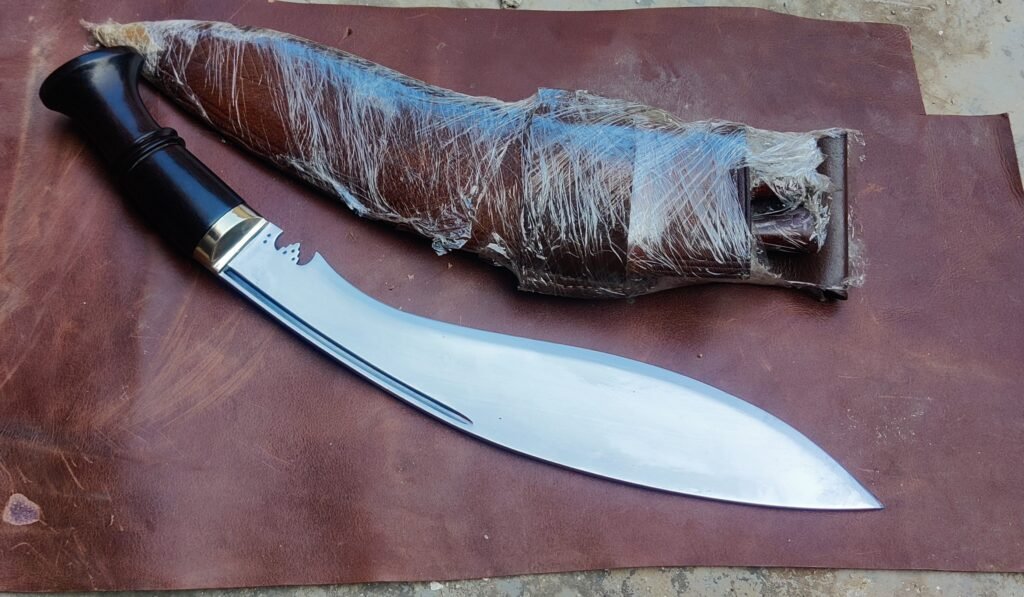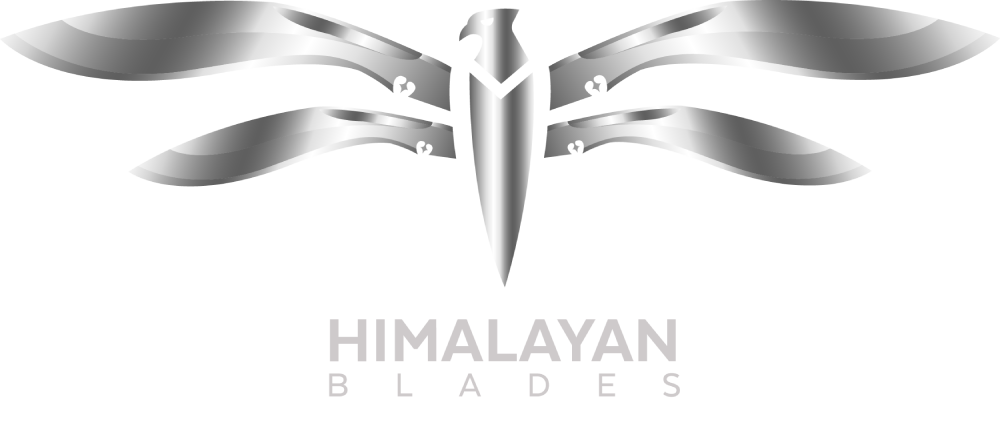The Origin of Khukuri (Kukri)

The Origin of the Khukuri (Kukri): The Iconic Weapon of the Gurkhas
The Khukuri, often spelled Kukri, embodies far more than just a blade; it represents the legacy, pride, and strength of the Gurkha soldiers and the people of Nepal. This iconic weapon carries a history rich in cultural significance, spanning centuries as generations of craftsmen shape it through warfare and tradition. Its unique shape and design make it one of the most distinctive blades globally, earning recognition for its exceptional functionality in both combat and utility.
Here, we explore the origin of the Khukuri, delving into its deep-rooted historical importance, evolution, and connection to the fierce Gurkha warriors who wielded it with skill and honor.
What is a Khukuri? Understanding the Distinctive Design
The Khukuri’s unique, forward-curving blade stands out immediately, creating a balanced, powerful chopping action. Its design blends functionality and symbolism, reflecting centuries of Nepalese culture and craftsmanship. Unlike straight-edged blades, the Khukuri’s curve directs force in a way that maximizes impact, excelling at various tasks, from combat to everyday activities.
The Anatomy of the Khukuri
A typical Khukuri consists of three main parts: the blade, the handle, and the scabbard. Each of these components is crafted with intention, reflecting the weapon’s symbolic and functional significance.

- Blade: The blade typically measures between 6 and 18 inches long, with a thickness ranging from 6mm to 1.2mm at the base. The blade is forward-curved, and the belly is wide. Traditionally forged from high-carbon steel, the blade features a sharp cutting edge.
The cho serves both practical and symbolic purposes, helping to prevent blood from reaching the handle (though this may not be accurate when considered from a physics perspective) and representing a spiritual mark deeply rooted in Hindu culture. - Handle: Typically made from wood, horn, or bone, the handle offers a secure grip, designed for powerful strikes. The shape of the handle often varies by region, with some handles featuring metal fittings, while others maintain a simpler wooden design. Craftsmen shape the handles for balance, allowing users to maintain control during both chopping and precision movements.
- Scabbard: The scabbard, often made of wood and covered with leather, protects the Khukuri when not in use. Many traditional scabbards include two small utility knives: the karda (for small tasks) and the chakmak (a sharpening tool).
The Khukuri’s design makes it a multi-functional tool suitable for chopping, slicing, and piercing. This unique shape has remained largely unchanged for centuries, underscoring its effectiveness in various environments.
Tracing the Origins: Ancient Roots of the Khukuri Design
The exact origin of the Khukuri is shrouded in mystery, but evidence suggests that it has been part of South Asian culture for over a millennium. Some historians propose that its design may have been influenced by ancient swords from Greece and Central Asia, which migrated to the Himalayas through trade and conquest.
Possible Historical Influences on the Khukuri Design

- Greek Kopis and Macedonian Influence: The forward-curving design of the Khukuri resembles that of the Greek Kopis and the Macedonian falcata, two ancient weapons known for their chopping power. Alexander the Great’s arrival in the Indian subcontinent in 326 BCE likely introduced these curved blades, which may have inspired early Khukuri designs. However, another theory suggests that the Khukuri design evolved from the sickle, a tool primarily used in farming, but also for hunting and fighting.
- Central Asian Influences: Central Asian nomadic tribes used curved blades effective in both close combat and mounted battles. The Khukuri likely drew elements from these traditions as trade and cultural exchange brought various blade designs to the Himalayan region.
- South Asian Sword Craftsmanship: Indigenous sword-making traditions in South Asia also contributed to the Khukuri’s form. The region’s early weapons often featured similar curves, suggesting that the Khukuri may have naturally evolved within the broader context of South Asian martial arts and craftsmanship.
The Rise of the Gurkhas: Establishing the Khukuri as a Weapon of Honor

The Gurkha warriors and their connection to the Khukuri is one of the most profound and celebrated aspects of Nepalese culture. This connection emerged most notably during the Anglo-Nepalese War (1814–1816), where the British first encountered the bravery and martial skills of the Gurkhas. The British were both impressed and overwhelmed by the Gurkhas’ fighting abilities, particularly their effective use of the Khukuri in close combat.
Iconic Battles and Legendary Gurkhas
During the Battle of Nalapani (1814), the Gurkhas defended their territory against a British army that was significantly larger. Armed primarily with Khukuris and limited firearms, the Gurkhas, under the command of Balbhadra Kunwar, held off British forces for weeks, inflicting heavy casualties. Stories from this battle spread through the British ranks, and the Khukuri gained a reputation as a fearsome and effective weapon.

Nalapani Battle
Another celebrated name in Gurkha history is Bhanubhakta Acharya, known for his bravery and loyalty in combat. His role in the Anglo-Nepalese War helped cement the image of the Khukuri-wielding Gurkha as a symbol of courage and determination.
Symbolism and Cultural Significance of the Khukuri in Nepalese Society
The Khukuri is more than just a weapon in Nepal—it serves as a cultural and spiritual symbol. For centuries, people have used the Khukuri in rituals, ceremonies, and even as a symbol of protection in households. The blade represents not only the martial prowess of the Gurkhas but also the strength and resilience of the Nepalese people.
Ceremonial Uses of the Khukuri
- Dashain Festival: During the Dashain festival, people bless Khukuris in religious ceremonies and use them in animal sacrifices, symbolizing the triumph of good over evil. The Dashain rituals reinforce the Khukuri’s significance as a protector and purifier.
- Weddings and Rites of Passage: People often present Khukuris as gifts during weddings and other rites of passage, symbolizing strength and resilience. Passing down a Khukuri from one generation to the next is a common practice, marking it as a family heirloom and symbol of continuity.
- Home Protection and Spiritual Belief: Many Nepalese households keep a Khukuri as a talisman, believing it wards off evil spirits and protects the family from harm. This practice emphasizes the blade’s role beyond physical defense—it serves as a guardian of spiritual well-being.
The Evolution of Khukuri Design Through the Ages

Despite its ancient origins, the Khukuri has evolved over time, adapting to different purposes and preferences. The blade has taken on various forms across different regions and historical periods, each variation offering insight into the diverse applications and stylistic preferences associated with the Khukuri.
Regional Variations in Khukuri Design
- Sirupate Khukuri: Named after the long, slender shape of a local grass, the Sirupate Khukuri is lighter and thinner than traditional models. It is often preferred in Eastern Nepal, where its lighter weight makes it suitable for daily tasks.
- Bhojpure Khukuri: Known for its broad blade, the Bhojpure Khukuri comes from the Bhojpur district. Heavier and thicker, it is ideal for heavy-duty tasks and is commonly used in the western regions of Nepal.
- Chitlange Khukuri: This ornate version of the Khukuri features decorative carvings on the blade and handle, highlighting the artistry of Nepalese blacksmiths. It is often reserved for ceremonial use or for display as a symbol of prestige.
Military Models: MK1 and MK2 Khukuris

The MK1 Khukuri and MK2 Khukuri represent modern adaptations of the traditional blade, developed for use by Gurkha regiments within the British and Indian armies. These versions are designed to meet military specifications, offering improved durability and uniformity.
The MK2, in particular, features a stronger spine and handle modifications, making it more suitable for the demands of modern military engagements.

Thry reflect the ongoing legacy of the Khukuri as a military tool, adapted to suit the requirements of contemporary warfare while retaining the essence of its historical design.
Craftsmanship of the Kukri: The Role of the Kami Artisans

Creating a Khukuri is a labor-intensive process that skilled craftsmen, known as Kami, undertake. Kami artisans have honed their craft over generations, combining precision, patience, and experience through traditional forging techniques. A Kami crafts each Khukuri not only to be functional but also as a piece of art, with every blade marked by its maker.
The Process of Making a Khukuri
- Metal Selection: Craftsmen use high-carbon steel, often sourced from recycled materials, to make traditional Khukuris. This type of steel balances sharpness and strength, ensuring the blade’s durability.
- Forging: Kami craftsmen heat the steel in a forge and then hammer it into shape over an anvil. This stage demands immense skill, as they must carefully control the shape and thickness to achieve the desired curve and balance.
- Tempering: After forging, the craftsmen heat the blade to high temperatures and then cool it rapidly, strengthening the steel and increasing resilience. This process creates a Khukuri that endures hard use and maintains a sharp edge.
- Grinding and Polishing: After tempering, craftsmen carefully grind the blade to refine its edge and create the Khukuri’s characteristic curve. They then polish the blade until it gleams, enhancing its appearance and protecting against corrosion.
- Handle Crafting and Assembly: Craftsmen carve handles from wood, buffalo horn, or sometimes bone, and fit them to the blade’s tang. A skilled Kami shapes the handle to ensure optimal weight distribution, allowing the Khukuri to feel comfortable and secure in the user’s grip.
- Scabbard Making: Craftsmen craft the scabbard from wood and wrap it in leather. They adorn some scabbards with intricate metalwork, showcasing their high level of artistry. Traditional scabbards also feature slots for the karda and chakmak, essential tools that complement the Khukuri’s utility.
The Khukuri-making process represents a revered art form among the Kami, who craft each blade uniquely. While craftsmen sometimes incorporate modern tools and materials, many Kami still follow traditional methods to preserve the Khukuri’s cultural heritage and authenticity.
The Khukuri in Modern Times: Legacy and Continued Relevance
Today, the Khukuri remains a symbol of Nepalese pride and holds high regard both within Nepal and internationally. The Gurkhas continue to use it in various capacities around the world, including in the British Army, the Indian Army, and the Singapore Police Force. In recent years, knife enthusiasts, collectors, and others who appreciate the Khukuri’s rich history and robust functionality have shown a growing interest in it.
Khukuri’s Role in the British and Indian Gurkha Regiments
The Gurkhas, known for their bravery and discipline, are undoubtedly an elite fighting force. The Khukuri not only forms an essential part of their gear but also their identity, representing their unique fighting style and heritage.
Both the British and Indian armies acknowledge the Gurkhas’ loyalty, resilience, and valor, and the Khukuri remains truly an inseparable part of this identity. British Gurkhas: The British have maintained Gurkha regiments since the Anglo-Nepalese War, with the Khukuri serving as both a weapon and a ceremonial emblem.
British officers often remark on the fierceness of the Gurkhas in battle, citing the Khukuri’s psychological impact on opponents. Indian Gurkhas: After India’s independence, India integrated several Gurkha regiments into its Army, where the Khukuri remains a critical part of their kit.
Gurkha officers present the Kukri to new recruits upon completing their training, thereby symbolizing their transition into warriors and protectors.
The Khukuri in Popular Culture and Modern Symbolism
The Khukuri has appeared in movies, television shows, and novels, gradually finding its way into popular culture. Typically, it is portrayed as a weapon of honor, associated with the bravery and integrity of the Gurkhas.
Over the years, legendary Gurkha warriors, like Lachhiman Gurung—who famously defended his position against a hundred enemies during World War II—have continued to showcase the Khukuri as more than just a blade.
Additionally, the Khukuri serves as a diplomatic gift and a symbol of Nepalese identity. Dignitaries and foreign visitors frequently receive it as a symbol of peace, strength, and friendship. As a result, this practice has expanded the Khukuri’s reputation as a cultural icon, recognized worldwide.
How the Khukuri Continues to Inspire and Influence Blade Crafting
The Kukri inspires modern knife-makers and outdoor enthusiasts, many of whom admire its unique design and practicality. Contemporary versions of the Khukuri are now used by outdoor survivalists, military personnel, and knife enthusiasts worldwide. Its durability and versatility make it an excellent tool for camping, bushcraft, and general survival activities.
Characteristics of Modern Khukuris
- Materials: While craftsmen traditionally make Kukri from high-carbon steel, modern versions often use stainless steel or other high-grade alloys to enhance durability and resistance to corrosion. These adaptations make the Khukuri suitable for diverse environments and conditions.
- Ergonomics and Design Enhancements: Sometimes modified with ergonomic handles and synthetic materials, modern Khukuris offer improved grip, durability, and comfort.
These updates allow the Khukuri to meet contemporary needs without sacrificing its distinctive shape and heritage. - Tactical Applications: The Khukuri’s efficient design has made it popular in various tactical applications.
Many modern-day soldiers and survivalists appreciate its balance of power and agility, making it a valuable addition to their gear.
Symbol of Heritage and Craftsmanship
The Khukuri has increasingly become a prized collector’s item, symbolizing Nepal’s rich history and the artistry of its craftsmen. In particular, handmade Kukri crafted by Kami artisans are especially sought-after, embodying centuries of traditional knowledge and skill.
As a result, as Nepalese communities continue to preserve this craft, the Khukuri represents an enduring and powerful link to Nepal’s cultural heritage, passed down through generations.
Conclusion: The Enduring Legacy
With its unique design, historical significance, and cultural symbolism, undoubtedly stands as a testament to Nepal’s resilience, artistry, and martial traditions. Spanning from its ancient roots to its modern applications, the Khukuri remains a powerful symbol of the Nepalese spirit.As such, as the weapon and tool of the Gurkhas, it has carved a place in history that resonates with courage, honor, and identity.
Moreover, whether wielded in battle or carried as a cultural emblem, the Khukuri represents a legacy of craftsmanship, heritage, and bravery. To this day, it endures as a revered and respected symbol.

